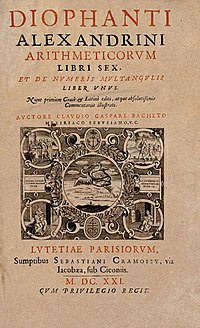Арифметика (Диофант): различия между версиями
Перейти к навигации
Перейти к поиску
| [непроверенная версия] | [непроверенная версия] |
Содержимое удалено Содержимое добавлено
Lordakryl (обсуждение | вклад) ← Новая страница: «[[Файл:Diophantus-cover.jpg|right|thumb|200px|Обложка издания 1621 года, перевод на [[латинский язык]…» |
Lordakryl (обсуждение | вклад) Нет описания правки |
||
| Строка 9: | Строка 9: | ||
''Арифметика'' стала известна мусульманским математикам в X веке<ref>{{cite book|first=Carl B.|last=Boyer|authorlink=Carl Benjamin Boyer|title=A History of Mathematics|edition=Second Edition|publisher=John Wiley & Sons, Inc.|year=1991|chapter=The Arabic Hegemony|isbn=0-471-54397-7|quote=Note the omission of Diophantus and Pappus, authors who evidently were not at first known in Arabia, although the Diophantine ''Arithmetica'' became familiar before the end of the tenth century.|page=234}}</ref>, когда [[ |
''Арифметика'' стала известна мусульманским математикам в X веке<ref>{{cite book|first=Carl B.|last=Boyer|authorlink=Carl Benjamin Boyer|title=A History of Mathematics|edition=Second Edition|publisher=John Wiley & Sons, Inc.|year=1991|chapter=The Arabic Hegemony|isbn=0-471-54397-7|quote=Note the omission of Diophantus and Pappus, authors who evidently were not at first known in Arabia, although the Diophantine ''Arithmetica'' became familiar before the end of the tenth century.|page=234}}</ref>, когда [[Абу-л-Вафа]] перевёл её на арабский язык<ref>{{cite book|first=Carl B.|last=Boyer|authorlink=Carl Benjamin Boyer|title=A History of Mathematics|edition=Second Edition|publisher=John Wiley & Sons, Inc.|year=1991|chapter=The Arabic Hegemony|isbn=0-471-54397-7|quote=Abu'l-Wefa was a capable algebraist as well as a trigonometer. He commented on al-Khwarizmi's ''Algebra'' and translated from Greek one of the last great classics, the ''Arithmetica'' of Diophantus.|page=239}}</ref>. |
||
== См. также == |
== См. также == |
||
Версия от 17:46, 19 августа 2012

Арифметика - старинная греческая рукопись по математике, написанная математиком Диофантом в 3 веке нашей эры. Это собрание 130 алгебраических задач с решениями в числах определенных (имеющих одно решение) уравнений и неопределенных уравнений..
Уравнения в книге называются Диофантовы уравнения. Метод для решения этих уравнений известен как Диофантов анализ. Большая часть задач Арифметики ведет к квадратичным уравнениям. Эти уравнения вдохновили Пьера Ферма предложить Великая теорема Ферма на полях его экземпляра «Арифметики», где указывается, что уравнение , где, , и ненулевые целые числа, не имеет решений при больше 2.
Арифметика стала известна мусульманским математикам в X веке[1], когда Абу-л-Вафа перевёл её на арабский язык[2].
См. также
Ссылки
- ↑ Boyer, Carl B. The Arabic Hegemony // A History of Mathematics. — Second Edition. — John Wiley & Sons, Inc., 1991. — P. 234. — «Note the omission of Diophantus and Pappus, authors who evidently were not at first known in Arabia, although the Diophantine Arithmetica became familiar before the end of the tenth century.». — ISBN 0-471-54397-7.
- ↑ Boyer, Carl B. The Arabic Hegemony // A History of Mathematics. — Second Edition. — John Wiley & Sons, Inc., 1991. — P. 239. — «Abu'l-Wefa was a capable algebraist as well as a trigonometer. He commented on al-Khwarizmi's Algebra and translated from Greek one of the last great classics, the Arithmetica of Diophantus.». — ISBN 0-471-54397-7.
Это заготовка статьи по математике. Помогите Википедии, дополнив её. |




